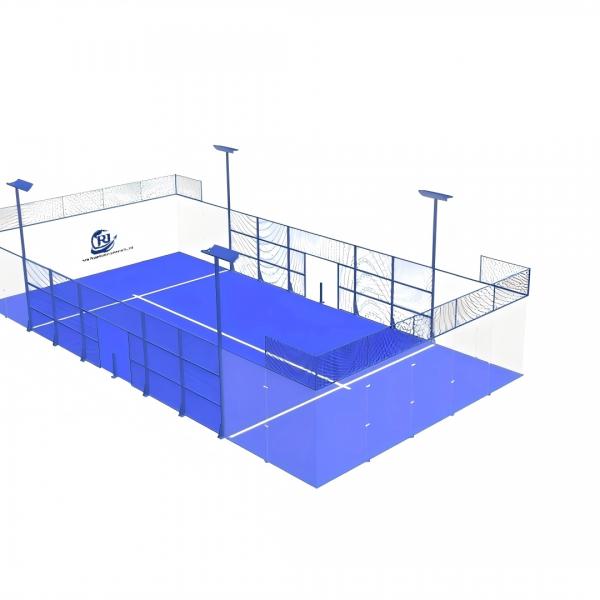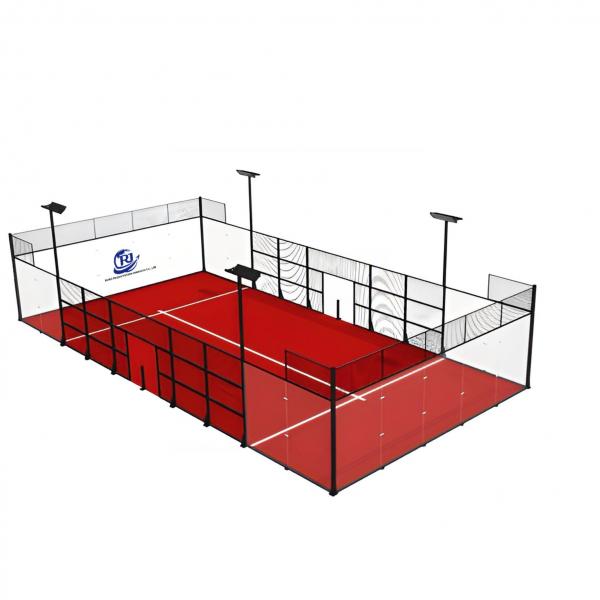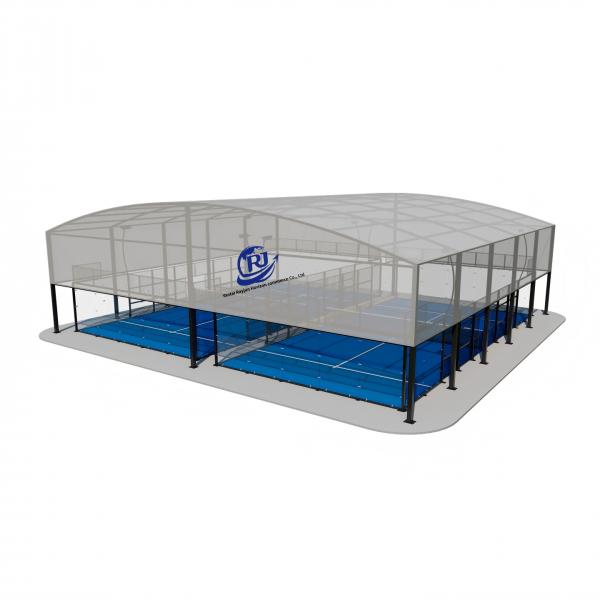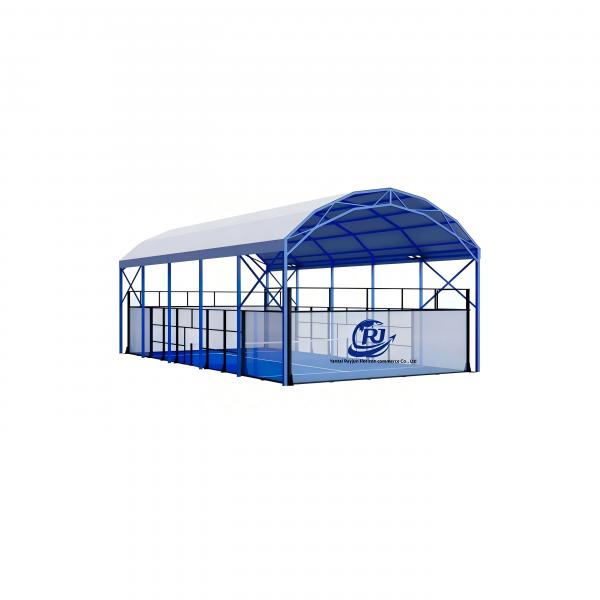Evaluating the quality of a padel court requires a systematic assessment of core structural components, playing surface performance, safety features, functional design, and long-term durability. Whether you’re a club owner investing in a new court, a player choosing where to train, or a tournament organizer verifying compliance, the following framework breaks down key evaluation criteria to ensure the court meets professional standards and user needs.
1. Playing Surface: The Foundation of Performance
The padel court surface directly impacts ball bounce, player traction, and injury risk—making it the most critical factor in quality. Professional courts must adhere to standards set by bodies like the International Padel Federation (FIP) or regional associations (e.g., PPA in the U.S., APT globally). Focus on these metrics:
a. Surface Material & Compliance
Padel courts use two primary surface types; each has strict quality benchmarks:
Artificial Grass (Most Common): Must be FIP-approved (e.g., brands like Laykold, Padel Galis, or Polytan). Key checks:
Fiber Density: 1,800–2,200 fibers per square meter (higher density prevents matting and ensures consistent ball interaction).
Fiber Length: 10–12mm (too short causes uneven bounce; too long slows the ball excessively).
Infill Quality: Uses a mix of silica sand (for weight/stability) and rubber granules (for shock absorption). The infill should be evenly distributed (15–20kg per square meter) and not clump or drain poorly.
Acrylic/Resin Surfaces (Rare, for Indoor Courts): Must have a textured finish to avoid slippage. Check for FIP certification for ball bounce consistency (should match artificial grass standards).
b. Ball Bounce Consistency
A high-quality court delivers uniform bounce across the entire playing area (no "dead spots" or unevenness). To test:
Hit balls repeatedly to different zones (corners, T-area, near walls) and observe if the bounce height (60–80cm when dropped from 1m) and angle stay consistent.
Avoid courts where balls bounce erratically (e.g., too high near edges, too low in center)—this indicates poor surface installation or uneven sub-base.
c. Traction & Shock Absorption
Traction: Walk/jog across the surface (dry and wet, if outdoor) to check for slip resistance. Artificial grass should provide "grip without stickiness"—players should feel stable during quick lateral movements (e.g., side steps, pivots) without their shoes catching.
Shock Absorption: The surface should cushion impacts to reduce joint strain (knees, ankles). FIP requires a "vertical deformation" of 2–5mm (measured via professional equipment). For a practical test, jump lightly: the surface should give slightly (not feel hard like concrete) but not sink excessively.
2. Structural Integrity: Frame, Walls, and Net
Padel courts are enclosed by walls and a net—their sturdiness, alignment, and compliance with dimensions are non-negotiable for safety and fair play.
a. Court Dimensions (FIP Mandatory)
First, verify the court meets standard size requirements (any deviation invalidates its quality for competitive use):
Component Standard Size (FIP)
Total Length (including walls) 10m
Total Width (singles/doubles) 6m / 8m
Wall Height (front/side) 3m (front) / 4m (side)
Net Height (center/posts) 0.88m (center) / 0.92m (posts)
Use a tape measure to confirm—even small discrepancies (e.g., 10cm too short) can alter gameplay.
b. Wall Quality & Durability
Walls are critical (padel allows ball rebounds off them), so evaluate:
Material: Professional courts use aluminum panels (lightweight, rust-resistant) or reinforced concrete (for outdoor durability). Avoid low-quality materials like plywood (prone to warping) or thin metal (dents easily).
Smoothness & Flatness: Walls should be uniformly smooth (no bumps, cracks, or rough edges) to ensure predictable ball rebounds. Run a level tool along the surface—gaps >2mm indicate poor installation.
Mesh Panels (Upper Section): The top 1m of side walls uses mesh (for visibility and air flow). Check that:
Mesh holes are 5–10mm (small enough to prevent fingers getting caught, large enough for visibility).
Mesh is taut (no sagging) and attached securely to the frame (no loose screws or gaps).
c. Net & Net Posts
Net Material: Must be made of durable polyester (resistant to UV and moisture) with a mesh size of 20–25mm. Avoid nylon nets (stretch over time) or thin polyester (rips easily).
Tension & Alignment: The net should be taut (no sagging in the center beyond the 0.88m height requirement) and aligned perfectly with the court’s center line. Net posts (usually steel or aluminum) should be stable (no wobbling) and have padding (to prevent injury if players collide).
3. Safety Features: Non-Negotiable for User Protection
A high-quality padel court prioritizes player safety—look for these non-negotiable features:
Edge Trimming: The playing surface should have rounded, rubberized edging (5–10cm wide) where it meets walls or the court perimeter. Sharp edges (e.g., exposed concrete or metal) pose a tripping or scraping risk.
Wall Padding: All hard surfaces (e.g., net posts, wall corners, door frames) should have 5–7cm thick foam padding covered in vinyl. Press on the padding to ensure it’s firm (not soft enough to collapse) but shock-absorbent.
Drainage (Outdoor Courts): Poor drainage leads to standing water (slippery surfaces and surface damage). Check:
The court has a slight slope (1–2% gradient) toward drains (no puddles after rain).
Drain grates are covered with mesh (to prevent debris clogging) and flush with the surface (no tripping hazards).
Lighting Safety (Indoor/Evening Play): LED lights (the industry standard) should be:
Positioned 4–5m above the surface (to avoid glare).
Evenly distributed (no dark spots—measured via a lux meter: minimum 500 lux for training, 750 lux for tournaments).
Equipped with shatterproof covers (to prevent glass/parts falling on players).
4. Functional Design & User Experience
Quality extends beyond performance—it should also cater to players’ comfort and practical needs:
Accessibility: The court should have wide entry doors (minimum 1.2m) for easy access (including for players with mobility aids). Steps (if any) should have handrails and non-slip treads.
Surroundings: Outdoor courts should have a 2–3m clear zone around the perimeter (no obstacles like trees, benches, or fences) to prevent collisions. Indoor courts should have adequate ventilation (to reduce humidity and odors).
Markings: Lines (service boxes, center line, baseline) must be:
Made of durable, UV-resistant paint (no fading or chipping).
5cm wide (FIP standard) and perfectly straight (use a level to check).
High-contrast (white on green/brown surfaces) for visibility.
5. Durability & Maintenance: Long-Term Value
A quality padel court should withstand years of use with minimal repairs. Evaluate these long-term factors:
Sub-Base Construction: The layer beneath the playing surface (usually gravel, sand, or concrete) must be compacted evenly (no settling). Ask the installer for details: e.g., "Was the sub-base compacted to 95% density?" (a key metric for preventing surface cracks).
Weather Resistance (Outdoor Courts):
UV Protection: Artificial grass should have UV-stabilized fibers (to prevent fading over 3–5 years).
Temperature Tolerance: Materials should withstand extreme heat (up to 50°C) or cold (down to -10°C) without warping or cracking.
Maintenance Requirements: A high-quality court reduces upkeep costs. Ask:
"How often does the artificial grass need brushing?" (Ideally 1–2 times per month, not weekly).
"Do the walls require annual repainting?" (Durable materials like aluminum should not).
6. Certification: The Final Quality Check
For professional or competitive use, always verify that the court is FIP-certified (or certified by a regional equivalent like the PPA). Certification ensures:
The court meets all size, surface, and safety standards.
Materials are tested for durability and performance.
The installer follows best practices for construction.
You can check FIP’s official database (or regional association websites) to confirm certification—avoid uncertified courts, as they may pose safety risks or fail tournament eligibility.
Summary: Quick Quality Checklist
To simplify evaluation, use this checklist before finalizing a court:
✅ Surface is FIP-approved (artificial grass/acrylic) with consistent bounce/traction.
✅ Court dimensions match FIP standards (10m x 8m for doubles).
✅ Walls are smooth, durable, and mesh panels are taut.
✅ Net is taut, aligned, and posts have padding.
✅ No tripping hazards (rounded edges, flush drains, padded hard surfaces).
✅ Outdoor courts have proper drainage; indoor courts have adequate lighting/ventilation.
✅ Court is FIP/regional association certified.
By focusing on these criteria, you can confidently assess whether a padel court delivers the performance, safety, and durability required for casual play, training, or competitive tournaments.








